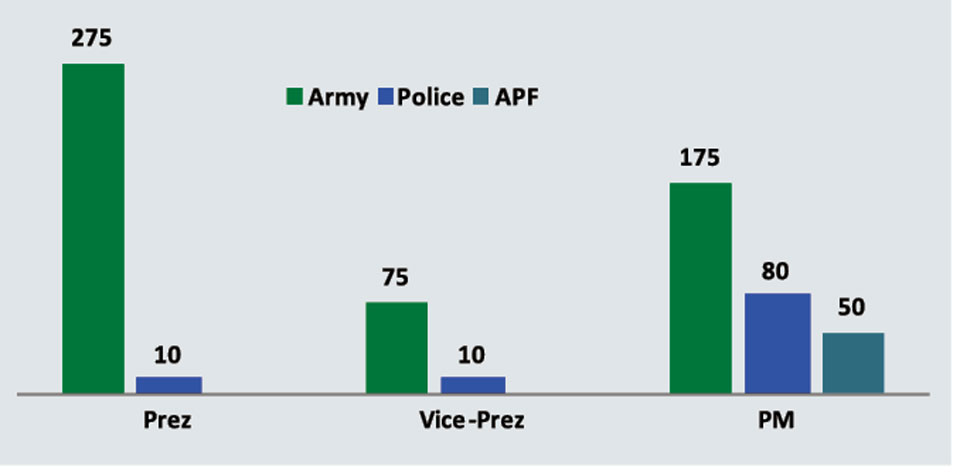285 security personnel for president alone cost Rs 8.2 million a month, 305 personnel for prime minister cost 7.8 million
KATHMANDU, July 13: Top officials of the state including the president, vice-president and prime minister are always surrounded by a huge security presence, just like in a situation of serious security threat.
However, given the normal political situation obtaining in the country of late, security experts are starting to wonder if the top officials are really at any risk.
The state has continued to provide costly security arrangements for a large number of incumbent and former officials, politicians and other personalities.
At least 275 army personnel and 10 from the police are deployed for the security of the president, 75 army and seven police personnel for the vice-president, and 175 army, 80 police and 50 armed police force personnel for the prime minister.
As per estimates by officials at various government agencies concerned, these security arrangements cost Rs 8.2 million a month in the case of the president and 7.8 million for the prime minister.
Smuggled goods worth over Rs 560 million seized in Parsa in 9 m...

Four layers of security are provided for the president, vice president, prime minister and also other ministers. The security personnel are deployed during their movements and to guard their residences. National Intelligence Department personnel are also deployed to gather and analyze information about any security threats.
Former officials including ex-prime ministers and ex-ministers are also provided security. Security personnel are deployed at their residences and large numbers of them provide security during their movements.
The VVIP security procedures prepared by the Home Ministry in 2013 classify incumbent and former officials into the four categories of VVIP, VIP, average and general. They are provided security on the basis of this classification and security threat assessments of very high, high, average and general.

Security expert Deepak Prakash Bhatta believes that our VVIPs are not under threat from any international terrorist group, separatist elements, rebel outfits or organized criminal gangs at present. “Our top state officials, political leaders and others may need to be provided security against any risk arising out of sudden anger on the part of some individual or other, but not against by any planned attack. This threat level falls under average security risk,” said Bhatta.
However, the security arrangements provided our top officials at present make it appear as if they are under serious security threat.
“None of the groups posing serious security threats are now active in Nepal. An average level of security arrangement is enough under these circumstances,” said Bhatta. “In providing a high level of security for our officials, we are giving an impression to the international community that Nepal is still a high security risk.”
Former additional inspector general Nabaraj Dhakal also believed that Nepal at present is in a situation of average security threat. “The regular movements of leaders and top officials also prove that they don’t feel any security threat. They regularly attend weddings and bratabandha and rice feeding ceremonies organized at party palaces. This shows they aren’t greatly worried about their security,” he said.
A committee comprising the secretaries of the home and defense ministries and the chiefs of all security agencies decides about the security arrangements to be provided to VVIPs, VIPs and others.
According to Dhakal, top officials and politicians were not provided large security details prior to the Maoist insurgency that started in 1996.
The security details were beefed up during the 10-year armed insurgency. But the top officials continued to enjoy the same levels of security even after the Maoists joined mainstream politics in 2006.
“The deployment of personnel for someone’s security should be based on the threat assessment but in our context a proper system hasn’t been developed for this,” said former AIG Dhakal.
Security expert Bhatta further claimed that in some cases there is also a practice of providing security even for individuals that do not qualify. “This is because of the tendency of security officials to keep politicians and top officials happy,” he said. “Moving around with a security detail has become a matter of prestige. This is clearly a misuse of taxpayer money. It has become imperative to change the underlying mindset.”
Home Ministry Spokesperson Deepak Kafle said the ministry is working on revising the directives for the deployment of security personnel for VIPs and big shots.


































